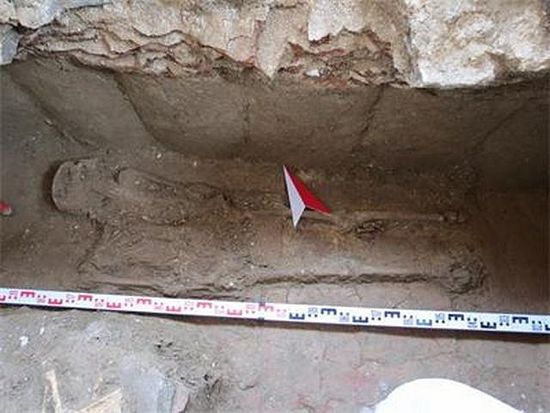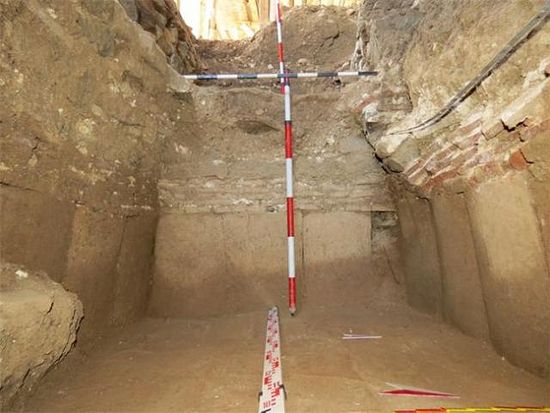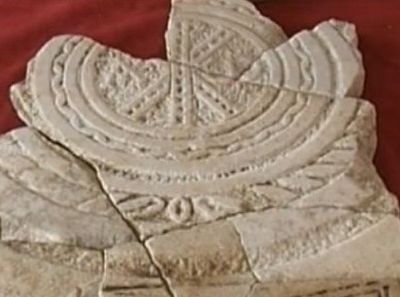Source: Archaeology in Bulgaria
October 11, 2015
 One of the two skeletons discovery in the 4th-5th century Early Christian tomb on the St. Ivan (St. John) Island in the Black Sea off the coast of Bulgaria’s Sozopol in August 2015. The skeletons may have belonged to Early Christian Syrian monks. Photo: 24 Chasa daily
One of the two skeletons discovery in the 4th-5th century Early Christian tomb on the St. Ivan (St. John) Island in the Black Sea off the coast of Bulgaria’s Sozopol in August 2015. The skeletons may have belonged to Early Christian Syrian monks. Photo: 24 Chasa daily
The two human skeletons discovered recently in an Early Christian tomb on the St. Ivan (St. John) Island in the Black Sea off the coast of Bulgarian resort Sozopol most probably belonged to Syrian monks who brought with them the relics of St. John the Baptist found on the same island in 2010.
The two human skeletons and a ram skeleton were discovered in August 2015 by Bulgarian archaeologist Prof. Kazimir Popkonstantinov inside the early Christian tomb on the St. Ivan Island off the coast of the town of Sozopol (the same island where relics of St. John the Baptist were found in the summer of 2010) which was found and opened in mid July 2015.
Popkonstantinov has revealed his latest conclusions about the 2015 summer discoveries that he has made amidst the ruins of the early Christian monastery “St. John the Baptist” on the St. Ivan Islandnow that the summer excavations have been completed, and the skeletons have been examined byanthropologists, reports the Bulgarian daily 24 Chasa.
The archaeologist has been excavating the Early Christian monastery for several years now; he made global headlines back in 2010 with the discovery of relics of St. John the Baptist; the fact that the relics belonged to a Middle Eastern man who lived in the 1st century AD has been confirmed by the analysis of scholars from Oxford University.
Upon the discovery of the reliquary containing the relics of St. John the Baptist back in 2010, Popkonstantinov and his team found next to it a matchbox-sized box made of sandstone (the type ofsandstone found in Middle Eastern countries such as Syria and Palestine); on it, there were aninscription in Ancient Greek, reading “God, save your servant Thomas (Toma). To St. John. June 24.” The date is the Christian feast day of St. John the Baptist, believed to be his birthday.
Popkonstantinov now says he has reasons to believe the two men whose skeletons he found buried in the early Christian tomb from in the 4th-5th century AD that he discovered in July-August 2015 most probably belonged to early Christian monks from Syria.
The archaeologist also thinks one of the two men might be the “Thomas (Toma)”, the man from the above-mentioned sandstone box inscription who brought the relics of St. John the Baptist to the small Black Sea island off the coast of Bulgaria’s Sozopol giving the start of the early Christian monastery named after the saint.
The tomb in question was found at a depth of 3.5 meters during excavations north of the altar of themonastery basilica which dates to the end of the 4th and the beginning of the 5th century AD. At the time, Sozopol and the St. Ivan Island were territory of the Eastern Roman Empire known today as Byzantium. In front of the tomb, the archaeologists discovered part of a sanctuary lamp, which is taken as evidence that it was the burial place of a senior clergyman.
Popkonstantinov notes that the basilica whose ruins he has been studying appears to be very similar to the early Christian churches in Syria known as “Syrian-type basilicas”.
“This discovery [i.e. the tomb] has no parallels in Bulgaria but also in Palestine and in Syria where one would expect to find such because the first basilica of the monastery has very close resemblance tochurches in Syria known as the Syrian-type basilica. It is a little known fact that lots of Syrian population settled in today’s Bulgarian territories, especially on the West Coast of the Black Sea, in the 5th-6th century AD,” the lead archaeologist is quoting as saying.
“The patriarchal monastery “St. John the Baptist” on the St. Ivan (St. John) Island is the largest and most ancient island monastery from the 5th century in the entire Black Sea. The archaeological excavations in 2015 have helped us clarify its early history,” Popkonstantinov adds.
Together with his colleagues, Assoc. Prof. Rosina Kostova and Milen Nikolov, the Director of the Regional Museum of History in Bulgaria’s Black Sea city of Burgas, he has established that the newly found early Christian tomb, which is 2.8 meters long and 1.8 meters wide, was built at the same time with the basilica.
The tomb of the two alleged Syrian monks, of which one may have brought the St. John the Baptist’s relics, while both men may have co-founded the monastery on the St. Ivan Island, is adjoined to the northern wall of the altar section of the basilica.
 The structure of the Early Christian tomb on the St. Ivan Island is unlike any other ancient tomb found in Bulgaria. Its floor and walls are tiled with 18 large equal-sized tiles, while its roof consisted of an arched structure. Photo: 24 Chasa daily
The structure of the Early Christian tomb on the St. Ivan Island is unlike any other ancient tomb found in Bulgaria. Its floor and walls are tiled with 18 large equal-sized tiles, while its roof consisted of an arched structure. Photo: 24 Chasa daily
“After completing the excavations we have found that the way [the tomb] was built differs from all other known tombs in Bulgaria from this time period. Its foundation is tiled with 18 tiles of equal size covering all four walls. Above the tiles comes the arched structure of the roof. Thefloor is tiled with the same kind of tiles,” Popkonstantinov explains.
The two skeletons, both of whom we about 1.60 cm (app. 5 feet 2.5 inches), were found on the floor of the tomb, lying about 40 cm (1.3 feet) from one another. Next to them the archaeologists have found 40 iron nails which apparently held together the respective wooden coffins.
The anthropological analysis of the bonesperformed by Assist. Prof. Viktoriya Ruseva has revealed that the skeleton found in the northern section of the early Christian tombbelonged to a man aged between 50 and 60, and the skeleton found in the southern section was 45-50 years old. The joints of both men show alterations caused by arthrosis.
The ram skeleton was found 25 cm above theyounger man’s skeleton; it is especially interesting because the sheep bones are absolutely intact in terms of their anatomical positions.
The Bulgarian archaeologists who have studied the tomb believe that both it and the first basilica on the St. Ivan Island off the coast of Sozopol were built at the same time, and thatboth were destroyed simultaneously by a powerful earthquake. As were the rest of themonastery buildings.
The natural disaster that affected the early Christian monastery supposedly led the monksto serve a prayer for mercy.
“The sheep was placed in the tomb as a votive offering, and on top of one of the buried men. According to the Syrian and Palestinian tradition, a tomb for the founders of the monastery is built next to the altar section of the basilica. The monastic brotherhood deemed the two founders of the monastery saintly men,pleaders before God,” Popkonstantinovelaborates.
Bone material from the skeletons of the twoalleged early Christian Syrian monks will be sent to the laboratories at Oxford University in the UK and the University of Copenhagen in Denmark which also examined the relics of St. John the Baptist found near Bulgaria’s Sozopol in 2010.
The results are expected to provide information about the age of the two men, when they were buried, what diseases they had, etc.
Bone material from the ram will be sent to a laboratory in Mannheim, Germany, in order to find out when the animal was buried. This information is expected to reveal in what year the earthquake occurred that shattered thetomb and the first basilica built at the monastery on the St. Ivan Island in the Black Sea.
“We are now firmly convinced that the first monastery was not destroyed by an invasionbut by this natural disaster. We and our colleagues from abroad are very impressed with thediscovery. No tomb of monastery founders, one of whom probably was the Thomas (Toma), has ever been found during excavations,” Popkonstantinov says.
This is the only monastery dedicated to St. John the Baptist where a reliquary with therelics of the saint has been found duringarchaeological excavations together with aninscription on a sandstone box in which they were transported. This is the first case in world Biblical and Christian archaeology in whichrelics of St. John the Baptist have been found in an archaeological environment. This is the first time that we have learned the name of the bearer of the relics – Thomas (Toma) – who is most probably one of the founders of themonastery, and was buried in this tomb together with the other founder
elaborates thearchaeologist.
Popkonstantinov points out that several hundred tourists and pilgrims from abroad, including Muslims who also worship St. John the Baptist, visit the ruins of monastery on the St. Ivan Island off the coast of Sozopol every day.
Despite this interest, the funding of theBulgarian government for the archaeological excavations of the St. John the Baptist Monastery is meager – about BGN 15,000 (app. EUR 7,300) per year. However, the excavationsare supported by the St. John the Baptist Foundation which provides money for the digsand the conservation of the archaeological structures every year.
Back in 2010 during excavations of an ancient monastery on the St. Ivan (St. John) Island in the Black Sea, off the coast of Bulgaria’s Sozopol, to the north of Burgas, Bulgarian archaeologist Prof. Kazimir Popkonstantinovdiscovered a reliquary containing relics of St. John the Baptist. The relics of St. John the Baptist, which consist of small bone particles from a skull, jaw bone, arm bone, and tooth, have received lots of international interest in the years since then, and in February 2015 CNN reported that Oxford University scholars had confirmed the possibility of their authenticity by concluding that they belonged to a man who lived in the Middle East at the same time as Jesus Christ.
Background Infonotes:
The history of the resort town of Sozopol (Apollonia Pontica, Sozopolis) on Bulgaria’s Southern Black Sea coast started during the Early Bronze Age, in the 5th millennium BC, as testified by the discoveries of artifacts found inunderwater archaeological research, such asdwellings, tools, pottery, and anchors. In the 2nd-1st millennium BC, the area was settled by the Ancient Thracian tribe Scyrmiades who were experienced miners trading with the entire Hellenic world. An Ancient Greek colonywas founded there in 620 BC by Greek colonistsfrom Miletus on Anatolia’s Aegean coast. The colony was first called Anthea but was later renamed to Apollonia in favor of Ancient Greek god Apollo, a patron of the setters who founded the town. It became known as Apollonia Pontica (i.e. of the Black Sea). Since the Late Antiquity, the Black Sea town has also been called Sozopolis.
The Greek colony of Apollonia Pontica emerged as a major commercial and shipping center, especially after the 5th century AD when it became allied with the Odrysian Kingdom, the most powerful state of the Ancient Thracians. As of the end of the 6th century BC, Apollonia Pontica started minting its own coins, with theanchor appearing on them as the symbol of the polis. Apollonia became engaged in a legendaryrivalry with another Ancient Greek colony, Mesembria, today’s Bulgarian resort town of Nessebar, which was founded north of the Bay of Burgas in the 6th century BC by settlers fromMegara, a Greek polis located in West Attica. According to some historical accounts, in order to counter Mesembria’s growth, Apollonia Pontica founded its own colony, Anchialos, today’s Pomorie (though other historical sources do not support this sequence of events), which is located right to the south of Mesembria. Apollonia managed to preserve its independence during the military campaigns of the Ancient Greek kingdom of Macedon under Philip II (r. 359-336 BC), and his son Alexander the Great (r. 336-323 BC). Apollonia, today’s Sozopol, is known to have had a large temple of Greek god Apollo (possibly located on the Sts. Quiricus and Julietta Island, also known as the St. Cyricus Island), with a 12-meter statueof Apollo created by Calamis, a 5th century BC sculptor from Ancient Athens. In 72 BC, Apollonia Pontica was conquered by Roman general Lucullus who took the Apollo statue to Rome and placed it on the Capitoline Hill. After the adoption of Christianity as the official religion in the Roman Empire, the statue was destroyed.
In Late Antiquity, Apollonia, also called Sozopolis lost some of its regional center positions to Anchialos, and the nearby Roman colony Deultum (Colonia Flavia Pacis Deultensium). After the division of the Roman Empire into a Western Roman Empire and Eastern Roman Empire (today known asByzantium) in 395 AD, Apollonia / Sozopolis became part of the latter. Its Late Antiquity fortress walls were built during the reign of Byzantine Emperor Anasthasius (r. 491-518 AD), and the city became a major fortress on the Via Pontica road along the Black Sea coast protecting the European hinterland of Constantinople.
In 812 AD, Sozopol was first conquered for Bulgaria by Khan (or Kanas) Krum, ruler of the First Bulgarian Empire (632/680-1018 AD) in 803-814 AD. In the following centuries of medieval wars between the Bulgarian Empire and the Byzantine Empire, Sozopol changed hands numerous times. The last time it was conquered by the Second Bulgarian Empire(1185-1396 AD) was during the reign of Bulgarian Tsar Todor (Teodor) Svetoslav Terter (r. 1300-1322 AD). However, in 1366 AD, during the reign of Bulgarian Tsar Ivan Alexander (r. 1331-1371 AD), Sozopol was conquered by Amadeus IV, Count of Savoy from 1343 to 1383 AD, who sold it to Byzantium. During the period of the invasion of the Ottoman Turks at the end of the 14th century and the beginning of the 15th century AD, Sozopol was one of the last free cities in Southeast Europe. It was conquered by the Ottomans in the spring of 1453 AD, two months before the conquest of Constantinople despite the help of naval forces from Venice and Genoa.
In Late Antiquity and the Middle Ages, Sozopol was a major center of (Early) Christianity with a number of large monasteries such as the St. John the Baptist Monastery on St. Ivan Island off the Sozopol coast where in 2010 Bulgarian archaeologist Prof. Kazimir Popkonstantinov made a major discovery by finding relics of St. John the Baptist; the St. Apostles Monastery; the St. Nikolay (St. Nikolaos or St. Nicholas) the Wonderworker Monastery; the Sts. Quriaqos and Julietta Monastery on the St. Cyricus (St. Kirik) Island, the Holy Mother of God Monastery, the St. Anastasia Monastery.
During the Ottoman period Sozopol was often raided by Cossack pirates. In 1629, all Christian monasteries and churches in the city were burned down by the Ottoman Turks leading it to lose its regional role. In the Russian-Turkish War of 1828-1829, Sozopol was conquered by the navy of the Russian Empire, and was turned into a temporary military base. After Bulgaria’s National Liberation from the Ottoman Empire in 1878, Sozopol remained a major fishing center. As a result of intergovernmental agreements for exchange of population in the 1920s between the Tsardom of Bulgaria and the Kingdom of Greece, most of the ethnic Greeksstill remaining in Sozopol moved to Greece, and were replaced by ethnic Bulgarians from the Bulgarian-populated regions of Northern Greece.
The modern era archaeological excavations of Sozopol were started in 1904 by French archaeologists who later took their finds to The Louvre Museum in Paris, including ancient vases from the beginning of the 2nd millennium BC, the golden laurel wreath of an Ancient Thracian ruler, and a woman’s statue from the 3rd century BC. Important archaeological excavations of Sozopol were carried out between 1946 and 1949 byBulgarian archaeologist Ivan Venedikov. The most recent excavations of Sozopol’s Old Town started in 2010. In 2011-2012, Bulgarian archaeologists Tsonya Drazheva and Dimitar Nedev discovered a one-apse church, a basilica, and an early Christian necropolis. Since 2012, the excavations of Sozopol have been carried out together with French archaeologists. In 2010, during excavations of the ancient monastery on the St. Ivan (St. John) Island in the Black Sea, off the coast of Bulgaria’s Sozopol, Bulgarian archaeologist Prof. Kazimir Popkonstantinov discovered a reliquary containing relics of St. John the Baptist. In 1974, the Bulgarian government set up the Old Sozopol Archaeological and Architectural Preserve.



